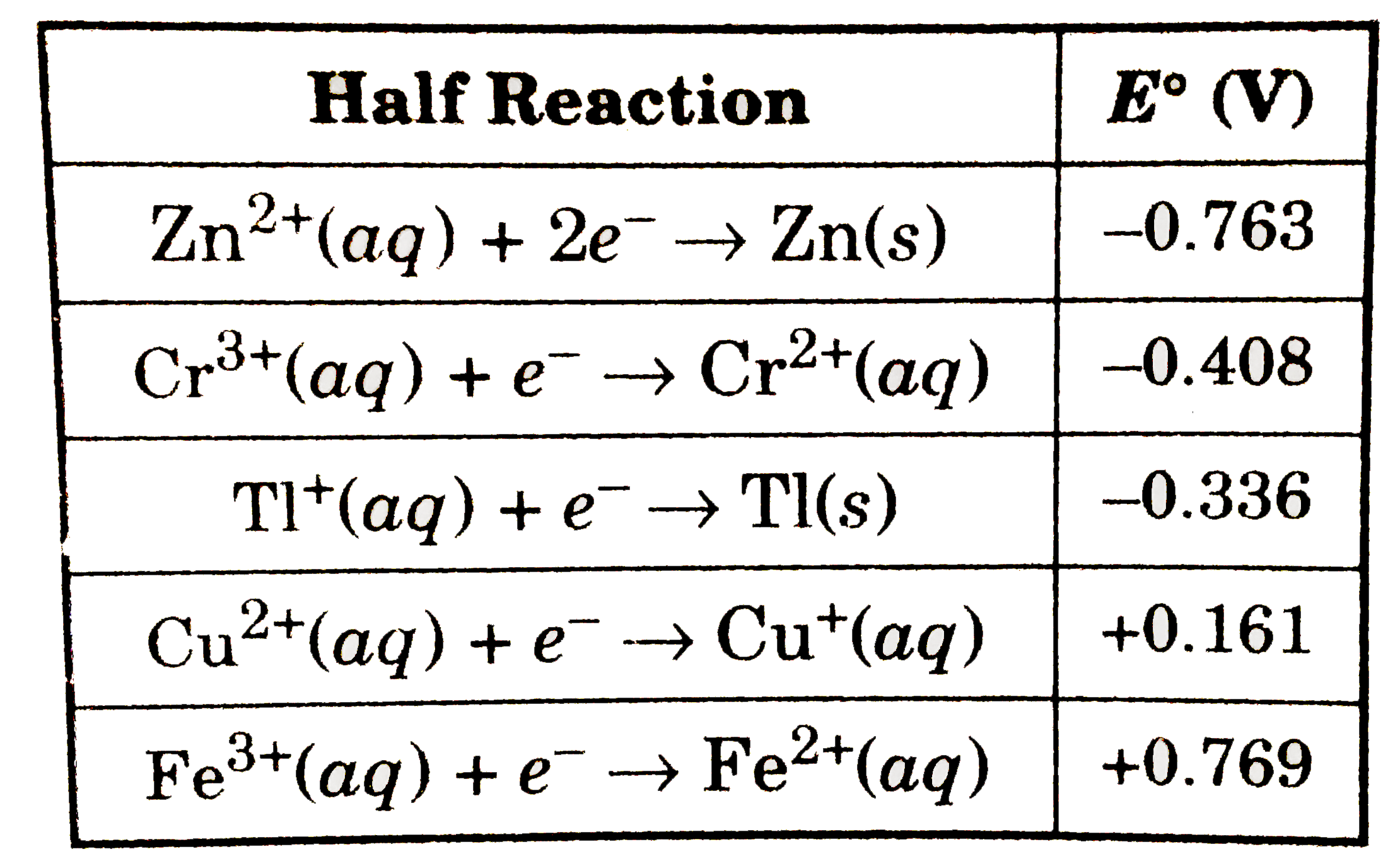NO−3(aq)+2H+(aq)+e−→NO2(g)+H2O. Calculate the reduction potential of the half reaction in neutral solution, if all other species to be at unit concentration and the standard reduction potential is 0.78 V. Solution in Telugu
The correct Answer is:0.046V
Step by step video, text & image solution for NO_(3)^(-)(aq) + 2H^(+) (aq) + e^(-) to NO_(2)(g) + H_2O. Calculate the reduction potential of the half reaction in neutral solution, if all other species to be at unit concentration and the standard reduction potential is 0.78 V. by Chemistry experts to help you in doubts & scoring excellent marks in Class 12 exams.
Topper's Solved these Questions
- BOOK - AAKASH SERIESCHAPTER - ELECTROCHEMISTRY EXERCISE - LEVEL-I ( EXERCISE-I)146videos
ELECTROCHEMISTRY
- BOOK - AAKASH SERIESCHAPTER - ELECTROCHEMISTRY EXERCISE - LEVEL-I ( EXERCISE-II)51videos
ELECTROCHEMISTRY
- BOOK - AAKASH SERIESCHAPTER - ELECTROCHEMISTRY EXERCISE - EXERCISE - 4.1.53videos
ELECTROCHEMISTRY
- BOOK - AAKASH SERIESCHAPTER - DILUTE SOLUTIONSEXERCISE - EXERCISE - 1.255videos
DILUTE SOLUTIONS
- BOOK - AAKASH SERIESCHAPTER - ELEMENTS OF D - BLOCKEXERCISE - EXERCISE - 5.233videos
ELEMENTS OF D - BLOCK
Similar Questions
Which one of the following materials conducts electricity ?
04:06View SolutionDuring the electrolysis of cryolite, aluminium and fluorine are formed in .... molar ratio
02:49View SolutionWhat is corrosion ? Discuss the methods for preventing corrosion .
01:48View SolutionWhat are the factor on-which solubility depends on ?
03:40View SolutionGive some examples for the ions with pseudo inert gas electronic configuration.
02:14View SolutionThe standard reduction potential for the half cell : NO_(3)^(c-)(aq)+2H^(c-) +e^(-) rarr NO_(2)(g)+H_(2)O is 0.78V . a. Calculate the reduction potential in 8M H^(o+) . b. What will be the reduction potential of the half cell in a neutral solution ? Assume all the other species to be at unit concentration.
02:08View SolutionThe standard reduction potential for H+(aq) is 0.00v. What is the reduction potential for a 1×10−3 M HCl solution?
05:08View Solution
Use the standard reduction potentials to find the standard cell potential E∘, for the reaction:
Zn(s)+2Tl+(aq)→Zn2+(aq)+2Tl(s)View Solutionwhat is the standard electrode potential for the reduction of HClO?
HClO(aq)+H+(aq+2e−→Cl−(aq)+H2O(l)
Given: Cr2(aq)→Cr3+(aq)+e−,E∘=0.41V
HClO(aq)+H+(aq)+2Cr2+(aq)→2Cr3+(aq)+H2O(l),E∘=1.8001:35View SolutionThe standard reduction potential for the half-cell, NO_(3(aq.))^(-)+2H_((aq.))^(+)+e^(-)rarrNO_(2(g))+2H_(2)O is 0.78V . (i) Calculate the reduction potential in 8M H^(+) . (ii) What will be the reduction potential of the half-cell in a neutral solution. Assume all the other species to be at unit concentration
07:47View SolutionThe standard oxidation potential for the half-cell NO_(2)^(-)(g)+H_(2)OtoNO_(3)^(-)(aq)+2H^(+)(aq)+2e is -0.78V . Calculate the reduction in 9 molar H^(+) assuming all other species at unit concentration. What will be the reduction potential in neutral medium?
05:08View Solutionनिम्नलिखित अर्द्ध - अभिक्रिया का मानक विभव 0.78 V है ।
NO−3(aq.)+2H+(aq.)+e→NO2(g)+H2O
(i) 8MH+ सांद्रता पर अर्द्ध-सेल का अपचयन विभव ज्ञात करो ।
(ii) उदासीन माध्यम में अर्द्ध - अभिक्रिया का अपचयन विभव क्या होगा, यदि अन्य सभी पदार्थो की सांद्रता 1 M मान ली जाये ।04:36View SolutionThe standard reduction potential of the half - cell:
NO−3(aq)+2H++e→NO2(g)+H2O is 0.78V.
(1) Calculate the reduction potential in 8 M H+.01:30View SolutionThe standard reduction potential of the half - cell: NO_(3)^(-)(aq)+2H^(+)+e rarr NO_(2)(g)+H_(2)O is 0.78V. (2) What will be the reduction potential of the half - cell in neutral solution? Assume all other species has unit concentration.
01:20View SolutionThe standard reduction potential of the following reaction at 25^(@)C, is 0.78V, NO_(3)^(-)(aq)+2H^(+)(aq)+e rarr NO_(2)+H_(2)O. (i) If the concentration of H^(+) is 8(M), what will be the standard reduction potential of the half - cell ? (ii) What will be the reduction potential of the half - cell in neutral solution? Suppose all other constituents are at unit concentration.
03:04View Solution

